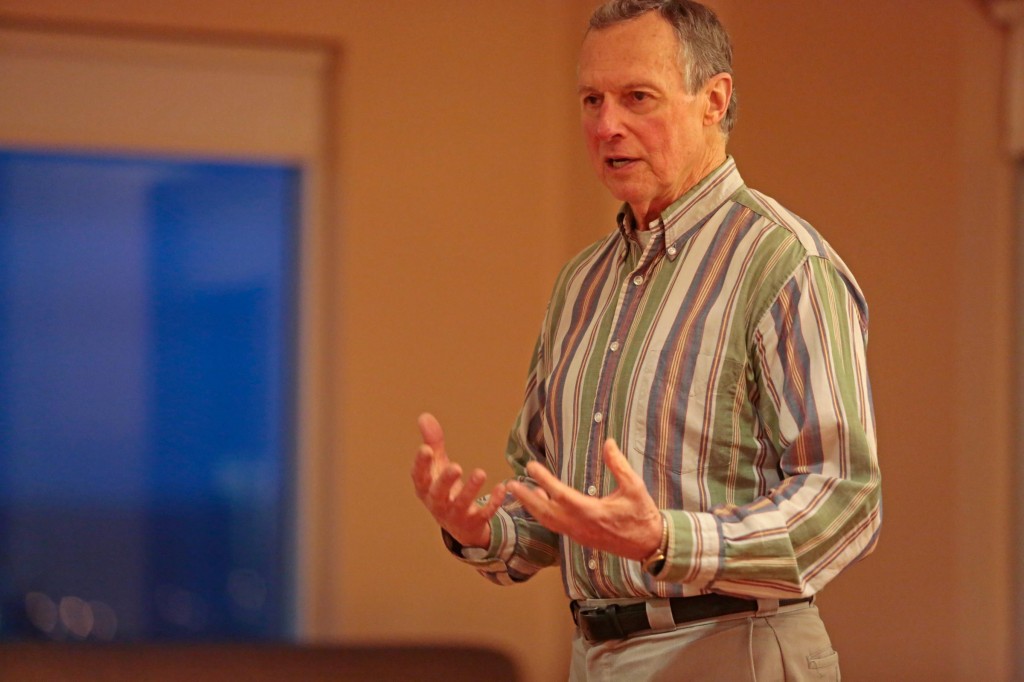
Though he wasn’t wearing a top hat or waving a medallion, professor Gary Truce showed students at Binghamton University the wonders of hypnotism during a lecture and live demonstration.
Truce, a physical health and wellness professor at BU, spoke to a crowd of more than 30 students at Appalachian Collegiate Center on Thursday night, sharing the theories behind hypnosis and his experiences hypnotizing people.
Truce explained how much of hypnosis deals with an individual’s subconscious mind, using the content of human dreams as an example since they are said to reflect our subconscious thoughts.
“One percent of everything we’re doing is real, 99 percent is our imagination,” Truce said. “Everything I’m talking about, you’re picturing in your mind.”
According to Truce, hypnotism has many uses, ranging from curing phobias to therapeutic procedures.
Truce actively uses the latter to work with a variety of people, from the New York Jets and the Washington Redskins for sports psychology, to pro race car drivers and actors in California to help get over fears and inhibitions.
Before his live experiment with the audience, Truce was able to choose the most “receptive” people via a pre-hypnotic test, which required audience members to close their eyes and hold their arms out. They were to picture one wrist being lifted by many balloons, and the other being weighed down by a dictionary. The people who had their arms spread furthest apart were chosen to participate.
The remaining audience members roared with laughter at the sight of the participants following the wild instructions of Truce. Initially instructed to fall asleep and then cuddle with the person beside them, some people were later barking, or attempting to sell circus refreshments. One person was told that there was a terrible smell in the room and was instructed to locate the source.
“I wasn’t embarrassed, I thought it was awesome,” said Gabriel Sierra, a sophomore majoring in accounting and the alleged source of the terrible smell.
Many of the participants emerged from the experiment bleary and red eyed. Several of them said that they were already forgetting what had happened.
“For me, [the] abnormal situations felt like they were normal. Where it would be weird to bark normally, it wasn’t weird to me,” said Ryan Shumaker, a freshman majoring in computer engineering.
Though the event was initially advertised as an activity to help teach people to self-hypnotize as a way to relieve stress, the professor was unable to get around to it as his story and demonstration took up the allotted time.
Before coming to teach at Binghamton University, professor Truce studied hypnosis for three years at the University of Cincinnati, where he was earning his master’s degree. He taught a class on parapsychology at Binghamton for 12 years before moving on to wellness classes.
“I was first interested in hypnosis when I was a senior in college and was trying to get over psychological blocks that I had pertaining to athletic performance,” Truce said.
He went on to explain how he became more involved while teaching in Cincinnati, immersing himself into the field at their medical school.
“There’s still a lot of people who don’t believe [in hypnosis] because they don’t understand it,” Truce said. “When you see a performance or demonstration, they are simply allowing themselves to go into this altered state of consciousness and receive those instructions.”
Resident assistants Naquan Ross and Alexis Stuts of Mountainview College coordinated the event after its initial success last year.
“Everyone who came had a great time, and even people who didn’t come heard how fun it was,” said Stuts, a senior majoring in accounting.
Stuts said she was glad to have been exposed to hypnosis.
“I think it’s great that we have Gary Truce as a resource that we can take advantage of,” she said.


